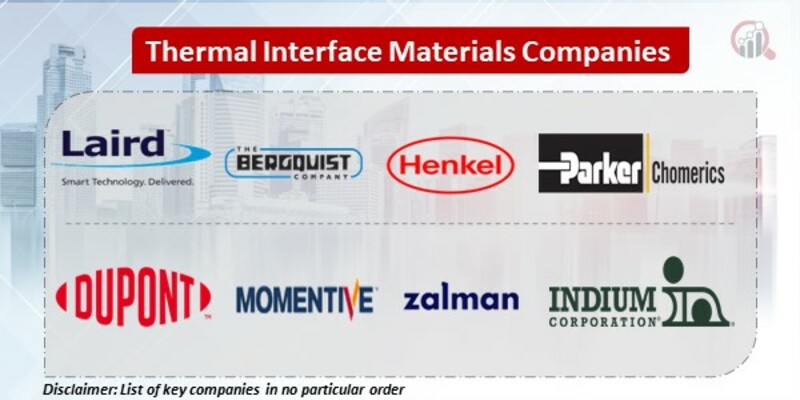Top Industry Leaders in the Thermal Interface Materials Market

Thermal Interface Materials Market
In the heart of every electronic device, there lies a silent hero – the thermal interface material (TIM). These unsung champions bridge the heat gap between hot chips and their cooling systems, ensuring efficient heat dissipation and preventing meltdowns. the TIM arena is a battleground of innovation, where established giants clash with nimble niche players, all vying for control of this microscopic battlefield.
The Thermal Champions and their Cooling Arsenal:
Global Titans: Behemoths like Dow Chemical, Henkel AG, and Parker Hannifin Corp. wield immense power through their vast production capacities, diverse material offerings, and established presence across various electronic sectors. Dow Chemical, with its THERMAX® line of silicones and greases, reigns supreme in the TIM realm.
Regional Contenders: Companies like Fujipol Corporation (Japan) and Beijing Techway Electronics Technology Co., Ltd. (China) excel in specific regions due to their localized expertise, regulatory knowledge, and strong relationships with regional electronics manufacturers. Fujipol caters to the booming Asian electronics market with its TIM solutions.
Niche Innovators: Smaller players like Bergquist Company (US) and Laird Technologies (US) specialize in high-performance, cutting-edge TIMs for demanding applications like aerospace, military electronics, and high-density computing. Bergquist offers advanced gap fillers and phase-change materials for extreme thermal management challenges.
Strategies that Cool the Competition:
-
Product Diversification: Offering a comprehensive range of TIMs for different applications, chip sizes, and heat loads attracts diverse customers. Henkel AG caters to consumer electronics, automotive, and industrial sectors with its varied thermal paste, pad, and film solutions.
-
R&D Prowess: Continuous innovation in material formulations, application methods, and thermal conductivity enhancement is crucial for market leadership. Parker Hannifin Corp.'s focus on next-generation liquid metal TIMs exemplifies this commitment.
-
Sustainability Focus: Addressing environmental concerns with bio-based, low-VOC, and recyclable TIMs aligns with customer preferences and regulatory compliance. Fujipol Corporation's development of bio-based thermal pads demonstrates this eco-conscious approach.
-
Cost Optimization: Streamlining production, utilizing recycled materials, and optimizing supply chains are key to maintaining competitive pricing. Beijing Techway Electronics benefits from domestic sourcing and efficient manufacturing processes.
-
Strategic Partnerships and Acquisitions: Collaborations with chipmakers, research institutions, and cooling technology companies can accelerate innovation and market reach. Bergquist Company's partnership with a leading aerospace manufacturer expands its reach into high-performance applications.
Factors Dictating Market Share Ascendancy:
-
Booming Electronics Market: Rising demand for smartphones, laptops, and wearable devices fuels the need for efficient thermal management solutions, favoring companies like Dow Chemical and Fujipol.
-
Miniaturization Trend: Shrinking electronic components and increasing heat density necessitate high-performance, thin-profile TIMs, positioning Bergquist and Laird Technologies for growth.
-
Electric Vehicle Revolution: The rise of electric vehicles and their high-powered battery packs demands advanced TIMs for managing extreme heat, creating opportunities for niche players like Henkel AG with its specialized EV solutions.
Key Companies in the Thermal Interface Materials market include
- Henkel Corporation
- Bergquist Company
- Indium Corporation
- Parker chomerics
- Dow Corning
- Laird Technologies
- Momentive performance materials Inc
- Zalman tech corporation limited.
Recent Developments:
May 2022: Arieca and ROHM Co., Ltd. worked together on a cooperative research project to create the market's materials for thermal interfaces for EVs. The project develops SiC power modules that will be next generation for xEV applications using Arieca's Liquid Metal Embedded Elastomer Technology or xEV applications.
November 2021: DuPont proudly announced the opening of their $30 million ground-breaking facility. It will provide a range of materials to promote electrified usage and lightweight building to meet the increasing need for its automotive adhesives. The newest factory will offer cutting-edge limits, effectiveness, and manufacturing capability. The manufacturing facility will be able to meet local demand. It will have excellent accessibility to logistics and shipping benefits and technical support to help guarantee a top-notch consumer experience.
April 2021: THERM-A-GAP GEL 75 was launched by the Parker Hannifin Corporation as disposable thermal interface material frequently used in high-powered devices and only required one component. The device is designed for power supplies, communications equipment, and automobile security modules.









